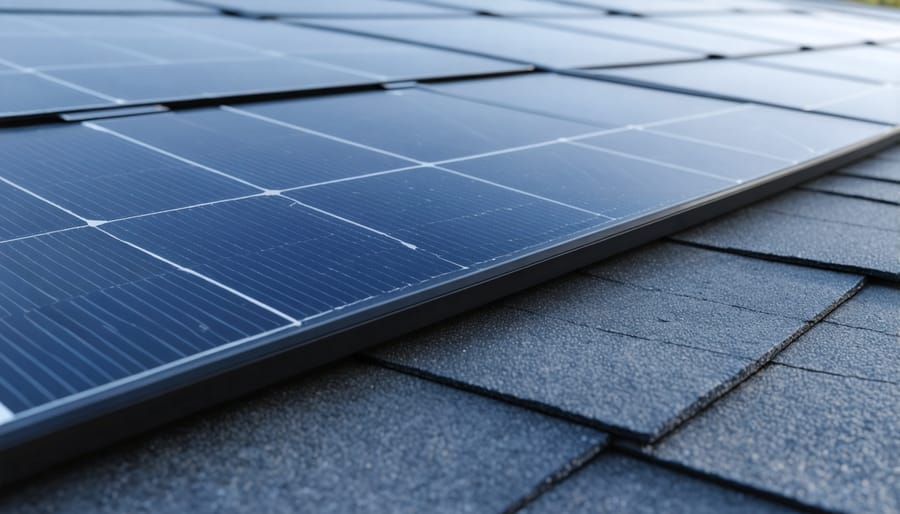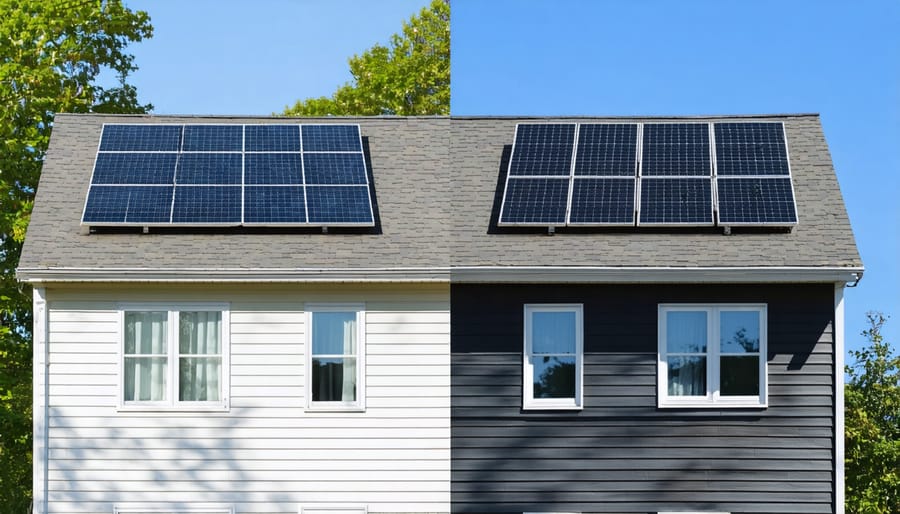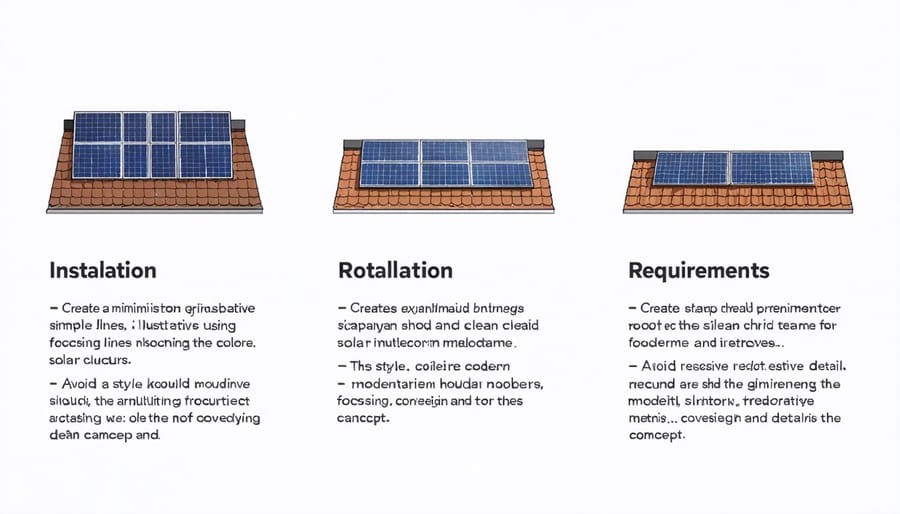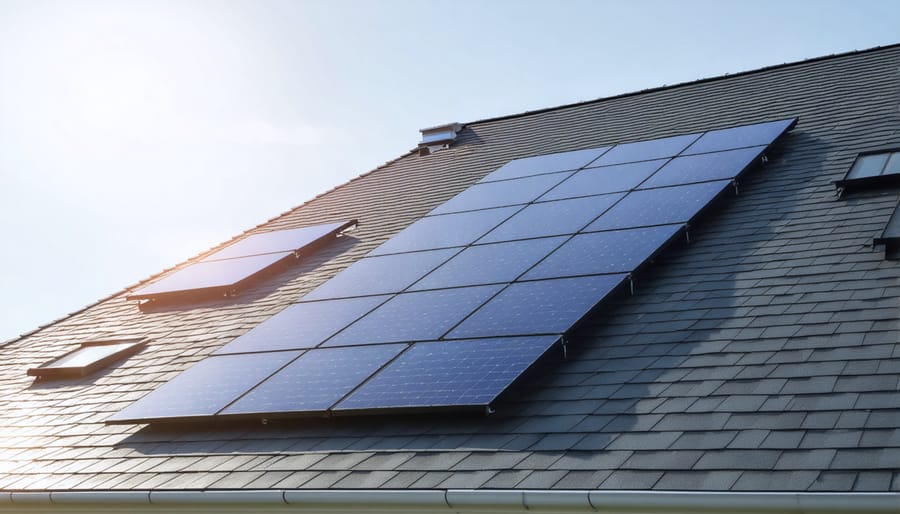Solar Shingles Transform Your Roof Into a Powerful Energy Generator
Transform your home into a power-generating masterpiece with integrated solar shingles – the revolutionary roofing solution that combines sophisticated solar technology with traditional architectural beauty. Unlike bulky solar panels, these sleek shingles seamlessly replace conventional roofing materials while capturing the sun’s energy to power your home. Recent advances have made solar shingles more efficient and affordable than ever, with modern systems converting up to 20% of solar energy into electricity while protecting your home just like traditional shingles.
Homeowners are increasingly choosing solar shingles not just for their environmental benefits, but also for their elegant aesthetic appeal and potential to increase property values by up to 4%. These innovative systems integrate perfectly with existing architecture, eliminating the industrial look of traditional solar panels while delivering the same sustainable energy benefits. With federal tax incentives covering up to 30% of installation costs and an average energy bill reduction of $1,200 annually, solar shingles represent a smart investment in both your home’s future and the planet’s well-being.
Whether you’re building a new home or planning a roof replacement, solar shingles offer a compelling opportunity to embrace clean energy without compromising your home’s curb appeal. As technology continues to advance and prices become more competitive, integrated solar shingles are rapidly becoming the preferred choice for forward-thinking homeowners.
How Solar Shingles Work: Beauty Meets Function
The Technology Inside
At the heart of integrated solar shingles lies cutting-edge smart solar technology that transforms ordinary roofing materials into powerful energy generators. These innovative shingles use photovoltaic cells made from thin-film semiconductor materials, typically silicon-based, that convert sunlight directly into electricity.
Each shingle contains multiple layers working together seamlessly. The top layer features tempered glass that protects the cells while allowing maximum sunlight penetration. Underneath, the photovoltaic material captures solar energy, while a specialized backing provides weatherproofing and durability comparable to traditional roofing materials.
What makes these shingles truly remarkable is their dual-functionality design. The cells are engineered to maintain optimal temperature and performance while functioning as regular roofing materials. They incorporate special thermal management systems that help maintain efficiency even during hot summer days.
The wiring system is cleverly concealed within the roofing structure, connecting individual shingles to create a powerful solar array that feeds into your home’s electrical system through a specialized inverter.

Seamless Integration
One of the most appealing aspects of modern solar shingles is their remarkable ability to blend seamlessly with traditional roofing materials. Unlike conventional solar panels that sit above your existing roof, these innovative shingles are designed to mirror the appearance of standard asphalt, slate, or tile shingles. This solar architecture integration ensures your home maintains its aesthetic appeal while incorporating renewable energy technology.
The shingles come in various colors and styles, making it nearly impossible for passersby to distinguish them from regular roofing materials. They’re installed in the same manner as traditional shingles, creating a uniform, sleek appearance across your entire roof. Many homeowners appreciate that there’s no visible transition between the solar and non-solar portions of their roof, preserving their home’s architectural integrity.
This seamless integration also means better protection for your home, as the solar shingles serve both as a power generator and a weatherproof roofing material. They’re designed to withstand the same environmental conditions as traditional shingles while providing the added benefit of clean energy production.
Benefits That Go Beyond Energy Savings
Aesthetic Appeal
One of the most striking advantages of integrated solar shingles is their seamless integration with your roof’s existing aesthetic. Unlike traditional solar panels that mount on top of your roof as bulky, visible additions, solar shingles blend naturally with your home’s architecture, creating a sleek, unified appearance.
These innovative shingles come in various styles and colors that match conventional roofing materials, from classic slate to modern architectural designs. The result is a sophisticated, clean look that maintains your home’s curb appeal while generating renewable energy. Many homeowners appreciate that their neighbors often can’t even tell they have solar technology installed.
For historic homes or properties in neighborhoods with strict architectural guidelines, solar shingles offer an elegant solution. They provide the perfect balance between preserving a building’s traditional character and embracing modern energy efficiency. Even better, the uniform, low-profile design eliminates shadows and raised edges that can trap leaves and debris, making maintenance simpler than with conventional solar panels.
Property value experts often note that solar shingles’ attractive appearance can positively impact resale value, as they represent both sustainable technology and architectural sophistication.

Financial Returns
Investing in integrated solar shingles can offer substantial financial returns through multiple channels. Homeowners can significantly reduce energy costs, with many reporting savings of 40-70% on their monthly electricity bills. These savings accumulate over time, often resulting in tens of thousands of dollars saved throughout the system’s lifetime.
The federal solar tax credit currently allows homeowners to deduct 30% of their solar installation costs from their federal taxes, making the initial investment more manageable. Many states offer additional incentives, including property tax exemptions, sales tax exemptions, and performance-based incentives that pay you for the energy your system produces.
Property value increases are another significant benefit of solar shingle installation. Recent studies show that homes with integrated solar systems sell for 4.1% more on average than comparable non-solar properties. For a $400,000 home, this translates to a potential increase of $16,400 in property value. Unlike traditional solar panels, solar shingles’ aesthetic appeal can make your property more attractive to future buyers.
The payback period for solar shingles typically ranges from 5 to 15 years, depending on factors like local electricity rates, solar exposure, and available incentives. With most systems warranted for 25-30 years, homeowners can enjoy free electricity for many years after reaching the break-even point. Some utility companies also offer net metering programs, allowing you to sell excess electricity back to the grid, further improving your return on investment.

Installation Process and Considerations
Professional Installation Requirements
Installing integrated solar shingles requires professional expertise to ensure optimal performance and maintain warranty coverage. Unlike traditional roofing, solar shingle installation demands specialized knowledge of both roofing and electrical systems.
Certified installers must complete manufacturer-specific training programs, typically offered by companies like Tesla, CertainTeed, or GAF Energy. These programs cover proper installation techniques, safety protocols, and system integration requirements. Installers need to understand both roof construction principles and solar power system components.
Key certification requirements include:
– Licensed electrical contractor certification
– Solar PV installation certification (NABCEP preferred)
– Local building code expertise
– Manufacturer-specific training completion
– OSHA safety certifications
The installation team typically consists of both roofing specialists and licensed electricians working together. The roofing experts handle the weatherproofing and structural aspects, while electricians manage the power system integration and grid connection.
Before hiring an installer, homeowners should:
– Verify all required certifications
– Check manufacturer authorization status
– Review past solar shingle installation projects
– Confirm warranty coverage terms
– Request detailed documentation of permits and inspections
Working with certified professionals not only ensures proper installation but also protects your investment through valid warranty coverage and compliance with local building codes. Most manufacturers maintain lists of authorized installers in different regions to help homeowners find qualified professionals.
Roof Assessment and Planning
Before installing integrated solar shingles, a thorough roof assessment is essential to ensure your home can support this innovative energy-efficient building design. Start by examining your roof’s age, condition, and structural integrity. Most solar shingle installations work best on roofs less than 5-7 years old, as you’ll want to avoid removing and reinstalling the system for roof repairs.
Consider your roof’s orientation and pitch. South-facing roofs typically capture the most sunlight in North America, while east and west-facing surfaces can still generate significant power. The ideal roof pitch for solar shingles ranges between 30-45 degrees, though modern systems can work effectively on slopes between 15-60 degrees.
Assess your roof’s square footage and shade patterns throughout the day. Take note of nearby trees, buildings, or other structures that might cast shadows on your roof. You’ll want to maximize exposure to direct sunlight for optimal energy production. Many homeowners choose to trim or remove obstructing tree branches as part of their preparation process.
Your local climate and weather patterns also play a crucial role. While solar shingles are designed to withstand various weather conditions, areas with heavy snowfall or frequent storms may require additional considerations for installation and maintenance.
Don’t forget to check local building codes and HOA regulations. Many communities have specific requirements for solar installations, including setbacks from roof edges and fire safety access paths. Working with a certified installer can help navigate these requirements and ensure your installation meets all necessary standards.
Lastly, evaluate your home’s electrical system. Your installer will need to assess your current electrical panel’s capacity and determine if upgrades are needed to accommodate the solar system. This preliminary planning helps avoid surprises during installation and ensures a smooth transition to solar power.
Cost Analysis and ROI
Initial Investment
The initial investment for integrated solar shingles typically runs higher than traditional solar panels combined with conventional roofing. On average, solar shingles cost between $15 to $25 per square foot installed, compared to $5 to $7 per square foot for standard asphalt shingles plus $7 to $9 per square foot for separate solar panels.
However, this cost comparison doesn’t tell the whole story. Solar shingles serve a dual purpose by functioning as both your roofing material and power generation system, potentially offering better value in the long run. When you’re already planning a roof replacement, the cost difference becomes less significant since you’re combining two projects into one.
For a typical 2,000-square-foot roof, expect to invest between $30,000 to $50,000 for a complete solar shingle installation. While this might seem steep compared to traditional options, many homeowners find the aesthetic appeal and seamless integration worth the premium. Additionally, various federal, state, and local incentives can significantly reduce your out-of-pocket expenses.
Consider that solar shingles often come with extended warranties covering both their roofing and power-generating functions, typically lasting 25-30 years. This comprehensive coverage, combined with potential energy savings and increased property value, helps offset the higher initial cost over time.
Long-term Value
Investing in integrated solar shingles offers substantial long-term financial benefits that extend well beyond the initial installation costs. Homeowners typically see a reduction of 40-60% in their monthly electricity bills immediately after installation, with some achieving even greater savings in sunnier regions.
The payback period for solar shingles generally ranges from 5 to 15 years, depending on factors such as local electricity rates, available solar incentives, and your home’s energy consumption patterns. In states with high electricity costs like California or Hawaii, homeowners often reach the break-even point closer to the 5-year mark.
Consider this: a typical 2,000-square-foot home with solar shingles can generate about 6,000 kilowatt-hours annually. At the national average electricity rate of $0.14 per kilowatt-hour, this translates to roughly $840 in annual savings. Factor in the rising costs of grid electricity (increasing by about 2.2% annually), and your savings continue to grow year after year.
Beyond direct energy savings, solar shingles increase your property value by an average of 4%. Real estate studies show that homes with integrated solar solutions sell faster and command higher prices than conventional properties. Additionally, many solar shingle systems come with 25-30 year warranties, ensuring decades of reliable energy production and financial returns on your investment.
As we’ve explored throughout this article, integrated solar shingles represent a remarkable fusion of traditional roofing and cutting-edge solar technology. These innovative solutions offer homeowners a unique opportunity to embrace clean energy while maintaining their home’s aesthetic appeal. Not only do they generate sustainable power, but they also provide excellent weather protection and can significantly reduce monthly energy bills.
The benefits extend far beyond just energy savings. From increased property value to potential tax incentives and rebates, solar shingles present a compelling investment for forward-thinking homeowners. Their seamless integration with existing architecture eliminates the bulky appearance of traditional solar panels, making them an attractive option for those conscious of their home’s curb appeal.
While the initial investment may be higher than conventional roofing, the long-term returns – both financial and environmental – make solar shingles worth considering. As technology continues to advance and prices become more competitive, these systems are becoming increasingly accessible to homeowners across different budget ranges.
Whether you’re building a new home or planning a roof replacement, now is the perfect time to consider integrated solar shingles. By making this sustainable choice, you’re not just investing in your property; you’re contributing to a cleaner, greener future while enjoying the benefits of modern solar technology. Take the first step toward energy independence and environmental stewardship by exploring solar shingle options for your home.









